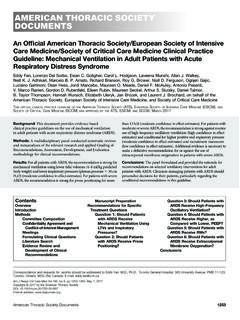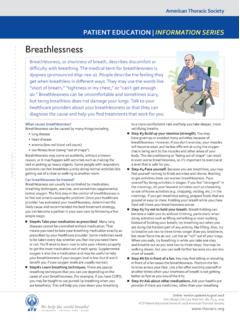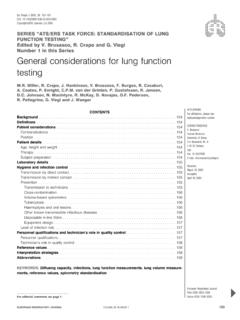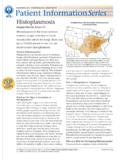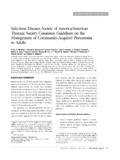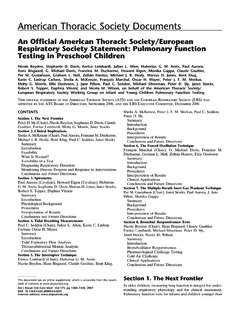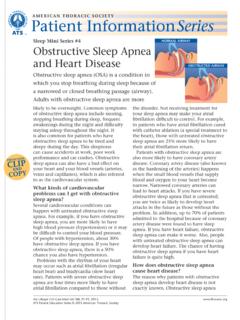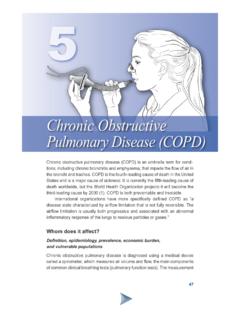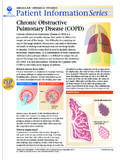Transcription of American Thoracic Society
1 American Thoracic Society Am J Respir Crit Care Med Vol 166. pp 111 117, 2002 DOI: address: ATS Statement: Guidelines for the Six-Minute Walk Test T HIS O FFICIAL S TATEMENT OF THE A MERICAN T HORACIC S OCIETY WAS APPROVED BY THE ATS B OARD OF D IRECTORS M ARCH 2002 CONTENTS Purpose and ScopeBackgroundIndications and LimitationsContraindicationsSafety IssuesTechnical Aspects of the 6 - Minute Walk TestRequired EquipmentPatient PreparationMeasurementsQuality AssuranceInterpretationReferences PURPOSE AND SCOPE This statement provides practical guidelines for the 6-minutewalk test (6 MWT). Specifically, it reviews indications, detailsfactors that influence results, presents a brief step-by-step pro-tocol, outlines safety measures, describes proper patient prep-aration and procedures, and offers guidelines for clinical inter-pretation of results.
2 These recommendations are not intendedto limit the use of alternative protocols for research do not discuss the general topic of clinical exercise with other American Thoracic Society statements onpulmonary function testing, these guidelines come out of aconsensus conference. Drafts were prepared by two members( and ) and were based on a comprehensive Med-line literature search from 1970 through 2001, augmented bysuggestions from other committee members. Each draft re-sponded to comments from the working committee. The guide-lines follow previously published methods as closely as possi-ble and provide a rationale for each specific final recommendations represent a consensus of the com-mittee. The committee recommends that these guidelines bereviewed in five years and in the meantime encourages furtherresearch in areas of controversy.
3 BACKGROUND There are several modalities available for the objective evalu-ation of functional exercise capacity. Some provide a verycomplete assessment of all systems involved in exercise per-formance (high tech), whereas others provide basic informa-tion but are low tech and are simpler to perform. The modalityused should be chosen based on the clinical question to be ad-dressed and on available resources. The most popular clinicalexercise tests in order of increasing complexity are stair climb-ing, a 6 MWT, a shuttle-walk test, detection of exercise-inducedasthma, a cardiac stress test ( , Bruce protocol), and a cardio-pulmonary exercise test (1, 2). Other professional organiza-tions have published standards for cardiac stress testing (3, 4).
4 Assessment of functional capacity has traditionally beendone by merely asking patients the following: How manyflights of stairs can you climb or how many blocks can youwalk? However, patients vary in their recollection and mayreport overestimations or underestimations of their true func-tional capacity. Objective measurements are usually betterthan self-reports. In the early 1960s, Balke developed a simpletest to evaluate the functional capacity by measuring the dis-tance walked during a defined period of time (5). A 12-minutefield performance test was then developed to evaluate thelevel of physical fitness of healthy individuals (6). The walkingtest was also adapted to assess disability in patients withchronic bronchitis (7).
5 In an attempt to accommodate patientswith respiratory disease for whom walking 12 minutes was tooexhausting, a 6-minute walk was found to perform as well asthe 12-minute walk (8). A recent review of functional walkingtests concluded that the 6 MWT is easy to administer, bettertolerated, and more reflective of activities of daily living thanthe other walk tests (9).The 6 MWT is a practical simple test that requires a 100-fthallway but no exercise equipment or advanced training fortechnicians. Walking is an activity performed daily by all butthe most severely impaired patients. This test measures the dis-tance that a patient can quickly walk on a flat, hard surface in aperiod of 6 minutes (the 6 MWD). It evaluates the global and in-tegrated responses of all the systems involved during exercise,including the pulmonary and cardiovascular systems, systemiccirculation, peripheral circulation, blood, neuromuscular units,and muscle metabolism.
6 It does not provide specific informa-tion on the function of each of the different organs and systemsinvolved in exercise or the mechanism of exercise limitation, asis possible with maximal cardiopulmonary exercise testing. Theself-paced 6 MWT assesses the submaximal level of functionalcapacity. Most patients do not achieve maximal exercise capac-ity during the 6 MWT; instead, they choose their own intensityof exercise and are allowed to stop and rest during the , because most activities of daily living are performedat submaximal levels of exertion, the 6 MWD may better reflectthe functional exercise level for daily physical activities. INDICATIONS AND LIMITATIONS The strongest indication for the 6 MWT is for measuring the re-sponse to medical interventions in patients with moderate tosevere heart or lung disease.
7 The 6 MWT has also been used asa one-time measure of functional status of patients, as well as apredictor of morbidity and mortality ( see Table 1 for a list ofthese indications). The fact that investigators have used the6 MWT in these settings does not prove that the test is clinicallyuseful (or the best test) for determining functional capacity orchanges in functional capacity due to an intervention in pa-tients with these diseases. Further studies are necessary to de-termine the utility of the 6 MWT in various clinical situations. 112 American JOURNAL OF RESPIRATORY AND CRITICAL CARE MEDICINE VOL 166 2002 Formal cardiopulmonary exercise testing provides a globalassessment of the exercise response, an objective determina-tion of functional capacity and impairment, determination ofthe appropriate intensity needed to perform prolonged exer-cise, quantification of factors limiting exercise, and a defini-tion of the underlying pathophysiologic mechanisms such asthe contribution of different organ systems involved in exer-cise.
8 The 6 MWT does not determine peak oxygen uptake, di-agnose the cause of dyspnea on exertion, or evaluate thecauses or mechanisms of exercise limitation (1, 2). The infor-mation provided by a 6 MWT should be considered comple-mentary to cardiopulmonary exercise testing, not a replace-ment for it. Despite the difference between these two functionaltests, some good correlations between them have been re-ported. For example, a significant correlation (r ) be-tween 6 MWD and peak oxygen uptake has been reported forpatients with end-stage lung diseases (36, 37).In some clinical situations, the 6 MWT provides informa-tion that may be a better index of the patient s ability to per-form daily activities than is peak oxygen uptake; for example,6 MWD correlates better with formal measures of quality oflife (38).
9 Changes in 6 MWD after therapeutic interventionscorrelate with subjective improvement in dyspnea (39, 40).The reproducibility of the 6 MWD (with a coefficient of varia-tion of approximately 8%) appears to be better than the re-producibility of 1-second forced expiratory volume in patientswith chronic obstructive pulmonary disease (COPD) (8, 41 43). Questionnaire indices of functional status have a largershort-term variability (22 33%) than does the 6 MWD (37).The shuttle-walking test is similar to the 6 MWT, but it usesan audio signal from a tape cassette to direct the walking paceof the patient back and forth on a 10-m course (44 47). Thewalking speed is increased every minute, and the test ends whenthe patient cannot reach the turnaround point within the re-quired time.
10 The exercise performed is similar to a symptom-limited, maximal, incremental treadmill test. An advantage ofthe shuttle walking test is that it has a better correlation withpeak oxygen uptake than the 6 MWD. Disadvantages includeless validation, less widespread use, and more potential forcardiovascular problems. CONTRAINDICATIONS Absolute contraindications for the 6 MWT include the follow-ing: unstable angina during the previous month and myocar-dial infarction during the previous month. Relative contraindi-cations include a resting heart rate of more than 120, a systolicblood pressure of more than 180 mm Hg, and a diastolic bloodpressure of more than 100 mm with any of these findings should be referred to thephysician ordering or supervising the test for individual clini-cal assessment and a decision about the conduct of the results from a resting electrocardiogram done during theprevious 6 months should also be reviewed before testing.
